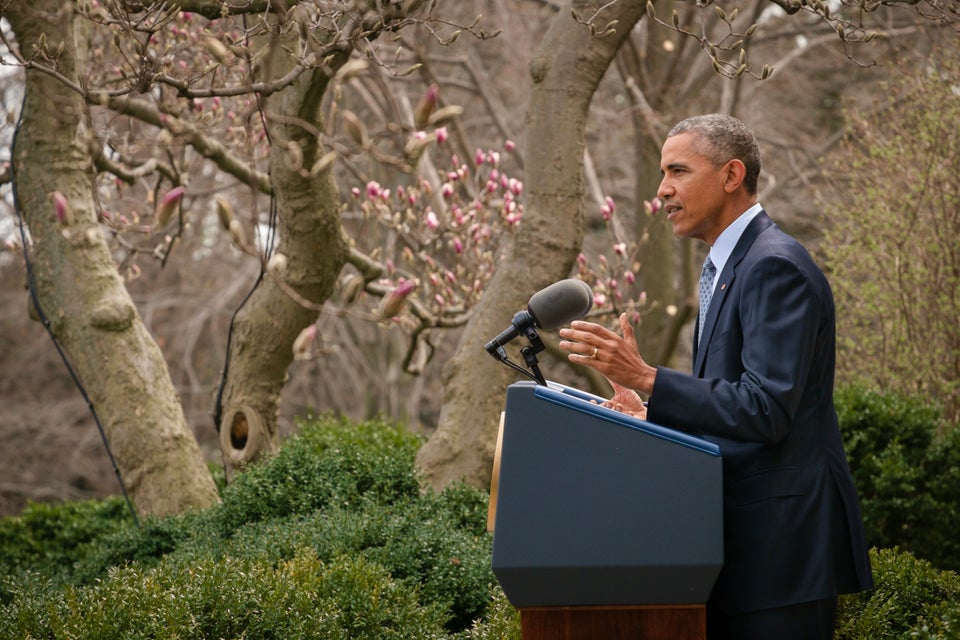In arguing against the Iran nuclear deal, Republican presidential candidate Mike Huckabee spins the facts.
Huckabee said “no American aircraft would be able to get through” the S-300 surface-to-air missile defense system that Iran plans to install. U.S. military officials and arms control experts dispute that assertion, including one expert who tells us Huckabee is “exaggerating.”
He also claimed the nuclear deal “lets Iran do their own inspections.” That’s wrong. Under the deal, the International Atomic Energy Agency would have daily access to and continuous monitoring at declared nuclear sites for at least 15 years. Huckabee was likely referring to a confidential side deal covering inspections at Parchin, a military site connected to nuclear weapon development. But the issue of inspections at that site is in dispute.

The IAEA Director General Yukiya Amano said claims of self-inspections “misrepresent the way in which we will undertake this important verification work” at Parchin.
Iran’s Plans for Defense System
The Iran nuclear deal, known as the Joint Comprehensive Plan of Action, is complex and parts of it aren’t even public. It’s easy for those who support or oppose the deal to spin the facts to suit their argument.
That’s what Huckabee, the former governor of Arkansas, is doing here when he presents opinions as facts.
A vocal opponent of the Iran nuclear deal, Huckabee discussed the deal and related issues on “Fox News Sunday.” At one point, Huckabee warned that the threat of a U.S. military strike should the Iranians violate the terms of the nuclear deal is meaningless, because Iran plans to purchase an advanced anti-aircraft defense system from Russia. The S-300 surface-to-air missile, as it is known, could be used to protect Iran’s nuclear sites from attack.
Huckabee, Aug. 23: The Iranians are right now, even before the deal is signed, negotiating with the Russians to get S-300 anti-aircraft weaponry, some of the most sophisticated, sophisticated enough that no American aircraft would be able to get through.
The claim that “no American aircraft” could penetrate the S-300s caught our attention. We asked the Huckabee campaign to support it, but didn’t get a response. If we do we will update this item.
The deployment of anti-aircraft missiles in Iran by most accounts would make a U.S. strike against Iran more difficult, but not impossible.
The Russian sale of the defense system to Iran has been in discussions for years. Russia first agreed to the sale in 2007, but suspended it in 2010 because of U.S. objections, as detailed by the New York Times. Despite continued U.S. opposition, Russia lifted the ban in April, leading to the most recent negotiations.
At an April 16 press conference, Gen. Martin Dempsey, chairman of the Joint Chiefs of Staff, said the military option in Iran would remain “intact” even if Iran purchases the S-300s. “[W]e’ve known about the potential for that system to be sold to Iran for several years, and have accounted for it in all of our planning,” Dempsey said.
Steven Pifer, a retired foreign service officer who now heads the Brookings Arms Control and Non-Proliferation Initiative, told us “Huckabee overstated the threat posed by the S-300 surface-to-air missile system.”
“The U.S. military has for decades invested significant resources to deploy the stealthy B-2 bomber, F-22 fighter and (now coming on line) F-35 fighter-bomber, as well as stand-off attack weapons and electronic countermeasures, to enable U.S. aircraft to conduct operations in areas defended by very sophisticated air defenses,” Pifer said in an email to us. “We will not know for sure unless the U.S. military has to fly against Iranian S-300s. If that had to happen, the smart money would be on the U.S. Air Force and Navy.”
Likewise, two research analysts at the Foundation for Defense of Democracies, which is headed by former CIA Director R. James Woolsey, co-wrote an op-ed in the congressional newspaper The Hill that said the U.S. and Israel both could penetrate the defense system.
“The S-300’s formidable capabilities do not, however, make Iran’s air-defenses immune to all threats,” they wrote. “Both Israel and the U.S. have experience training against Western-acquired S-300s. And although both air forces have yet to face an S-300 battery in combat, there is little doubt they would be able to counter the system.”
Iran’s Self-Inspections?
Huckabee then went on tell guest host Shannon Bream that “this deal … lets Iran do their own inspections.”
Huckabee, Aug. 23: So this is just — I mean — I mean it’s balloon juice for the president to get out there and pretend that this deal is a good one, in part, Shannon, because this lets Iran do their own inspections, do their self-reporting. It’s like letting a tenth grader grade his own algebra exams or letting Hillary Clinton take care of her own server. Both are nonsense and this deal is nonsense.
First, let’s clear up what Huckabee is talking about.
Huckabee’s does not explain the reference to self-inspections, making it seem like he is talking about all inspections. That’s wrong and could leave some viewers with a false impression of the nuclear deal.
Under the JCPOA, the IAEA would have daily access to declared nuclear sites for 15 years and continuous electronic monitoring of those sites for at least 15 years, as explained in a 67-pageguidebook published by the Belfer Center for Science and International Affairs at Harvard University.
Huckabee was most likely referring to a controversial side deal involving the Parchin military site, which has been the site of past high-explosive testing that the IAEA suspects is connected to nuclear weapon development. That separate agreement has not been made public, but the Associated Press on Aug. 19 wrote that a draft copy of the agreement indicated that “Iran will be allowed to use its own inspectors to investigate.”
IAEA Director General Yukiya Amano responded to the AP article by issuing a statement that said, “I am disturbed by statements suggesting that the IAEA has given responsibility for nuclear inspections to Iran. Such statements misrepresent the way in which we will undertake this important verification work.”
Amano didn’t explain the inspection process because the agreement is confidential. In his statement, he only said “the arrangements are technically sound and consistent with our long-established practices.”
The confidential agreement on Parchin and the claim that it allows Iran to self inspect has become a major issue in recent days.
The American Security Initiative, a bipartisan group of four former senators, has begun running TV ads targeting Democratic Sens. Cory Booker of New Jersey and Bob Casey of Pennsylvania that feature the AP story and a young man who says Iran sponsored the terrorist group that killed his father. In the ad, the man says, “This news about them self-inspecting. It doesn’t make sense. I wonder why we’re giving up so much control. We cannot allow Iran to self inspect.”
As with many aspects of the nuclear deal, the facts are in dispute.
Thomas Shea, a former IAEA inspector who once headed the agency’s Trilateral Initiative Office in the Department of Safeguards, co-wrote an op-ed for The Hill that carried the headline, “No, Iran is not allowed to inspect itself.” He wrote that IAEA inspectors will likely oversee Iranian collection of samples at Parchin.
Shea and Mark Hibbs, Aug. 21: The IAEA and Iran have developed a protocol to allow this to happen in a way that ensures, to the satisfaction of both parties, the integrity of the process. Without knowing the precise details of the IAEA’s understanding with Iran, IAEA inspectors at Parchin will likely oversee the taking of multiple samples using environmental sampling kits that the IAEA has prepared. Multiple samples would be prepared at each location identified by the IAEA inspectors. Each side would obtain samples taken with the kits. Critically, the IAEA would have samples using kits prepared in advance by its own laboratory.
Tariq Rauf, who once headed IAEA’s Verification and Security Policy Coordination Office, explained how that process could work on his website Atomic Reporters:
Rauf, Aug. 20: Under regular IAEA safeguards inspections, Agency inspectors carry out the swiping and collection of samples, as at Bushehr, Esfahan, Natanz, Fordow and elsewhere in Iran. Parchin being a military industrial facility is not subject to regular IAEA safeguards as it is not a “nuclear facility” as defined for purposes of IAEA safeguards. The IAEA, however, can request and obtain access to a facility such as Parchin under “managed access” provisions of Iran’s Additional Protocol (AP) to its safeguards agreement with the IAEA. It would be unusual but by no means technically compromising to have Iranian technicians collect swipe samples at sites and locations at Parchin in the physical presence and direct line of sight of IAEA inspectors, including filming, and using swipe kits and collection bags provided by the IAEA.
However, David Albright, an IAEA weapons inspector in Iraq during the 1990s and founder of the Institute for Science and International Security, writes in the Washington Post that IAEA inspectors will not be present during the sample collection. He writes, “The IAEA will not be able to visit Parchin until after the samples are taken, and it remains doubtful that the inspectors will be able to take additional samples.”
In an email to us, Albright said he got his information from unnamed “congressional sources, based on briefings by senior U.S. officials.” He questioned whether Rauf knows the details of the agreement.
“Rauf’s statement that you quote is largely what would be expected if normal IAEA procedures were followed and Rauf does not imply any knowledge of the actual Parchin agreement in this statement,” Albright said. “The Parchin agreement is not normal, so it is to be expected that the procedures would vary from the standard ones.”
Rauf acknowledged that he has not seen the confidential agreement, “but neither has Mr. Albright.” He told us in an email that he based his op-ed “on the actual practices of the IAEA” and the reassurance by Amano that the arrangements with Iran are “consistent with established IAEA safeguards practices.”
At an Aug. 24 press briefing, White House spokesman Josh Earnest was asked about the AP report and referred reporters back to Amano’s statement.
“The fact is that the arrangements between Iran and the IAEA are sound and consistent with the IAEA’s long-established practice; that the IAEA in developing this inspection plan didn’t compromise its safeguards or standards in any way,” Earnest said.
There is no resolution to this dispute at this point and perhaps there won’t be unless the agreement is made public or if the IAEA fully explains the verification process that it will use at Parchin.
But this much is clear: Huckabee’s statement that the nuclear deal “lets Iran do their own inspections” is at the very least in dispute. And, because he didn’t make clear what part of the nuclear deal he was talking about, viewers could have easily been left with the false impression that he was talking about all inspections. That would be wrong.
Also on HuffPost:

